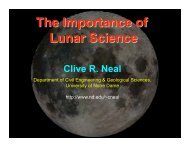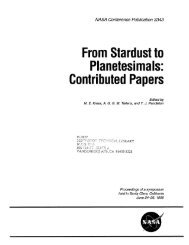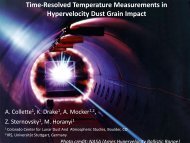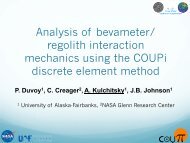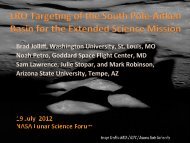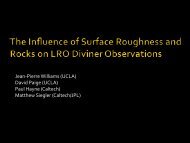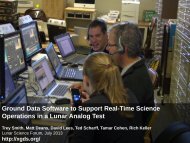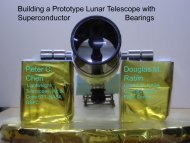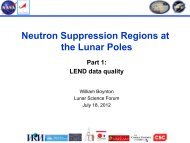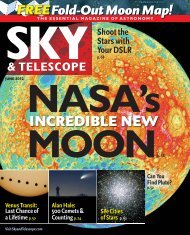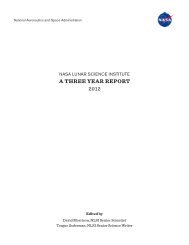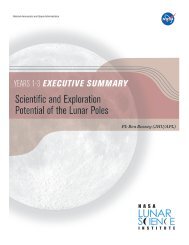Dusty Plasma Processes on the Surfaces on Airless Planetary Objects
Dusty Plasma Processes on the Surfaces on Airless Planetary Objects
Dusty Plasma Processes on the Surfaces on Airless Planetary Objects
Create successful ePaper yourself
Turn your PDF publications into a flip-book with our unique Google optimized e-Paper software.
<str<strong>on</strong>g>Dusty</str<strong>on</strong>g> <str<strong>on</strong>g>Plasma</str<strong>on</strong>g> <str<strong>on</strong>g>Processes</str<strong>on</strong>g> <strong>on</strong> <strong>the</strong><br />
<strong>Surfaces</strong> <strong>on</strong> <strong>Airless</strong> <strong>Planetary</strong> <strong>Objects</strong><br />
M. Horanyi and <strong>the</strong> CCLDAS Team <br />
<strong>Objects</strong> without a global magnetic field or an atmosphere in a flowing plasma:<br />
Mo<strong>on</strong>, Phobos, Deimos, Asteroids, mo<strong>on</strong>s in planetary magnetospheres<br />
1
and operati<strong>on</strong><br />
J. Carpenter, 2012 <br />
7<br />
2
Many issues remained open.<br />
Images shortly after<br />
sunset <br />
LEAM: <br />
Lunar Ejecta and<br />
Meteorite Experment <br />
3
<str<strong>on</strong>g>Dusty</str<strong>on</strong>g> plasma issues are relevant to several groups. <br />
Lunar Science and Engineering: charge state, <strong>the</strong> size and velocity<br />
distributi<strong>on</strong> of levitated/transported lunar fines as a functi<strong>on</strong> of local<br />
time, and positi<strong>on</strong> al<strong>on</strong>g <strong>the</strong> lunar orbit. <br />
Basic <str<strong>on</strong>g>Plasma</str<strong>on</strong>g> Science: buildup and collapse of a plasma and<br />
photoelectric sheath, and its changing properties with dust loading. <br />
<strong>Planetary</strong> and Astrophysical Sciences: Understand <strong>the</strong> mechanism<br />
leading to dust transport <strong>on</strong> airless bodies. Reliably distinguish<br />
between interplanetary and interstellar grains, measure <strong>the</strong>ir fluxes,<br />
size and velocity distributi<strong>on</strong>s, and compositi<strong>on</strong>. <br />
4
• Space%wea<strong>the</strong>ring%(solar%wind%/%meteoroids)%<br />
Magnetic fields can be important. <br />
• Distribu8<strong>on</strong>%of%water%<br />
Clemen8ne%750%nm%reflectance% OH%abundance%derived%from%M 3%<br />
30%km%<br />
Kramer et al., 2011<br />
10%<br />
Solar Wind Shielding by Magnetic Hood and Field Schubert, (Hood and 1980 Schubert <br />
Issue: Micrometeoroids<br />
5
et al., 2010].<br />
a variety of<br />
parallel and<br />
si<strong>on</strong>al plasm<br />
and l D > r i ,<br />
i<strong>on</strong>s, and l<br />
studies were<br />
field c<strong>on</strong>figu<br />
[6] In this<br />
interacti<strong>on</strong>s w<br />
surface and<br />
lunar magne<br />
Small-scale experiments are helpful.<br />
A06226<br />
WANG ET AL.: PLASMA-DIPOLE FIELD IN<br />
2. Experi<br />
[7] The ex<br />
stainless stee<br />
diameter, sho<br />
Xu et a., 2012 is<br />
obtained<br />
created by t<br />
from a negat<br />
Figure 1. Schematic of experimental and diagnostic setup.<br />
of <strong>the</strong> chamb<br />
<strong>the</strong> primary<br />
[3] Siscoe and Goldstein [1973] modeled two basic A magnetic 6
Str<strong>on</strong>g localized electric fields emerge. <br />
Potential distributi<strong>on</strong><br />
i<strong>on</strong>s <br />
electr<strong>on</strong>s <br />
I<br />
II<br />
III<br />
IV<br />
7
The c<strong>on</strong>figurati<strong>on</strong> of B matters. <br />
i<strong>on</strong>s <br />
Mirror<br />
reflecti<strong>on</strong> <br />
Electr<strong>on</strong> <br />
focusing <br />
8
UV radiati<strong>on</strong> drives dayside charging. <br />
Sternovsky et al., 2008 <br />
9
UV experiments are hard.<br />
• 0.6 m 3 , 60-cm<br />
diameter vacuum<br />
chamber<br />
UV lamps<br />
• 10 -6 Torr operating<br />
vacuum<br />
Collector<br />
Biased grid<br />
• Collector and grid aid<br />
in obtaining clean<br />
measurements<br />
• Xe-excimer UV lamps<br />
peak emissi<strong>on</strong> at 172<br />
nm (7.21 eV)<br />
Planar probe<br />
Zr surface<br />
Cylindrical<br />
probe<br />
To electr<strong>on</strong>ics<br />
Motor<br />
10
UV Charging (Cerium-Oxide) <br />
10.0000<br />
CeO 2 solid<br />
CeO 2 powder<br />
1.0000<br />
Current (µA)<br />
0.1000<br />
0.0100<br />
0.0010<br />
0.0001<br />
-30 -20 -10 0 10 20 30<br />
Probe Bias<br />
Dove et al., 2011, 2012<br />
11
Topography effects everything.<br />
12
Topography effects everything.<br />
13
A spacecraft alters its envir<strong>on</strong>ment.<br />
14
Topography effects everything.<br />
15
Dust moves around <strong>the</strong> surface. <br />
Szalay et al., 2012 <br />
16
Dust accumulates in craters. <br />
Poppe et al., 2012 <br />
17
Dust p<strong>on</strong>ds can form. <br />
Classificati<strong>on</strong>:<br />
C - Carb<strong>on</strong>aceous<br />
S - Silicaceous<br />
M - Metallic<br />
“P<strong>on</strong>ding” <strong>on</strong><br />
Eros<br />
LRO - LAMP
LETTER<br />
Even a fine dust layer can interferes with remote sensing search for volatiles.<br />
RESEARCH<br />
a b c<br />
10<br />
0<br />
–10<br />
–20<br />
10<br />
0<br />
–10 0 10 20<br />
d<br />
4.0 e f<br />
10<br />
0<br />
–10<br />
–20<br />
–10 0 10 20<br />
–10 0 10 20<br />
1.50<br />
0.75<br />
0.00<br />
–0.75<br />
–1.50<br />
–2.25<br />
–3.00<br />
–3.75<br />
3.5<br />
3.0<br />
2.5<br />
2.0<br />
1.5<br />
1.0<br />
0.5<br />
0.0<br />
Topography (km)<br />
Surface roughness<br />
(RMS m)<br />
–10<br />
–20<br />
89° S<br />
20° W 10° W 0° 10° E 19° E 30° E<br />
Slope<br />
(degrees)<br />
0–5<br />
5–10<br />
10–15<br />
15–20<br />
20–25<br />
25–30<br />
30–35<br />
35–40<br />
40–45<br />
45–50<br />
I<br />
E<br />
X<br />
D<br />
0 km 5<br />
Figure 1 | Detailed characterizati<strong>on</strong> of Shacklet<strong>on</strong> crater. a, Topography in<br />
km; b,percentageoftimeilluminated;c, 10-m baseline slopes in degrees;<br />
d, surface roughness shown as RMS residual in m; e, locati<strong>on</strong>s of crater counts<br />
50+<br />
F<br />
C<br />
B<br />
A<br />
G<br />
F<br />
X<br />
I<br />
14° E<br />
X<br />
80<br />
70<br />
60<br />
50<br />
40<br />
30<br />
20<br />
10<br />
0<br />
Percentage<br />
89° S<br />
89° S<br />
10<br />
0<br />
–10<br />
–20<br />
10<br />
0<br />
–10<br />
–20<br />
–10 0 10 20<br />
–10 0 10 20<br />
30<br />
25<br />
20<br />
15<br />
10<br />
5<br />
0<br />
0.5<br />
0.4<br />
0.3<br />
0.2<br />
Zuber et al., 2012 <br />
floor; A/B, entire crater floor; C, crater wall; D, crater rim crest; E/F, inner rim<br />
annulus (,5.5 km); E, inner rim annulus excluding steep regi<strong>on</strong> (F); F, steep rim<br />
regi<strong>on</strong> within annulus; G, crater wall secti<strong>on</strong>; I, Shacklet<strong>on</strong> crater deposits north of<br />
Slope (degrees)<br />
I/F<br />
19
ttgart, Germany)<br />
LADEE/LDEX will help.<br />
Pre-Shipment Review<br />
June 7, 2012<br />
20
The measurement establishes a direct link of <strong>the</strong> grains compositi<strong>on</strong> to its origin <strong>on</strong> <strong>the</strong> surface (compositi<strong>on</strong>al<br />
mapping). In <strong>the</strong> course of <strong>the</strong> missi<strong>on</strong> a dust spectrometer is collecting many thousands of submicr<strong>on</strong> samples from<br />
a greater part of <strong>the</strong> entire surface and determines <strong>the</strong>ir origin and compositi<strong>on</strong>. It thus combines in situ analysis,<br />
which o<strong>the</strong>rwise could <strong>on</strong>ly be achieved by a lander, with <strong>the</strong> much better surface coverage of a remote sensing<br />
method.<br />
LDEX will map <strong>the</strong> lunar dust envir<strong>on</strong>ment.<br />
Figure 1. Schematics of dust spectrometry of a planetary surface. Ejecta particles lifted by micro-meteoroid<br />
impacts from <strong>the</strong> satellites' surface are analyzed in situ by a sensor in combinati<strong>on</strong> with a high-resoluti<strong>on</strong> dust<br />
mass spectrometer. By tracing back <strong>the</strong> trajectory to <strong>the</strong> surface compositi<strong>on</strong>al maps of <strong>the</strong> surface are<br />
generated.<br />
The analysis of emitted solids is complementary to studies by remote sensing methods (e.g. by infrared<br />
spectroscopy) and analysis of <strong>the</strong> gas phase (by an i<strong>on</strong> and neutral mass spectrometers). It is important that both,<br />
solid and gas phases be measured. For example, Cassini’s dust detector CDA (Srama et al., 2004) found sodium salts<br />
in <strong>the</strong> dust particles from Saturn’s satellite Enceladus (e.g. Postberg et al., 2009), while high-resoluti<strong>on</strong> spectroscopy<br />
and <strong>the</strong> Cassini INMS did not detect any sodium in <strong>the</strong> emerging plume gas or at <strong>the</strong> mo<strong>on</strong>’s surface (Schneider et<br />
al., 2009; Waite et al., 2009). Only <strong>the</strong> combinati<strong>on</strong> of all methods provides a c<strong>on</strong>clusive picture. There is ano<strong>the</strong>r<br />
remarkable advantage of ‘surface dust spectrometry’: Whereas remote sensing methods determine <strong>the</strong> compositi<strong>on</strong>al<br />
average of a certain area, a dust spectrometer is able to identify individual c<strong>on</strong>stituents of that area <strong>on</strong> a submicr<strong>on</strong><br />
level. Ideally, <strong>the</strong> c<strong>on</strong>tributi<strong>on</strong> of certain minerals and compounds to a specific geological formati<strong>on</strong> can be<br />
quantified.<br />
The process of creating ejecta from impacting micrometeroids is very efficient: <strong>the</strong> total mass is of <strong>the</strong> order of a few<br />
thousand times of <strong>the</strong> impactor’s mass (Koschny & Grün., 2001). The predicted density of ejecta grains in <strong>the</strong> lunar<br />
dust exosphere at an altitude of 50 km is shown in Fig. 2. In additi<strong>on</strong>, during meteor showers, <strong>the</strong> ejecta populati<strong>on</strong> is<br />
expected to dramatically increase with a spatial distributi<strong>on</strong> showing str<strong>on</strong>g deviati<strong>on</strong>s from spherical symmetry for a<br />
durati<strong>on</strong> of a few days.<br />
3<br />
21
02/2011 <br />
22
Linear Time-of-Flight Mass Spectrometer<br />
• Measures velocity distributi<strong>on</strong> of <strong>the</strong> i<strong>on</strong>s<br />
• Narrow instrument aperture - filtering <strong>the</strong> angular distributi<strong>on</strong><br />
• Few sec<strong>on</strong>dary i<strong>on</strong>s due to ejecta<br />
CCLDAS 23 20
Time-of-Flight Mass Spectrum<br />
CCLDAS<br />
25 23<br />
Hear talk by Anna Mocker, Fri. 8:40 am
A dust detector in orbit can unabiguously detect ice from <strong>the</strong> surface. <br />
26
Dust instruments are ready.<br />
27
Strategic<br />
Knowledge Gap<br />
Determining near-surface<br />
plasma envir<strong>on</strong>ment and<br />
nature of differential<br />
electrical charging at<br />
multiple lunar localities<br />
(includes PSRs)<br />
Strategic Knowledge Gaps<br />
III. Understand how to work<br />
and live <strong>on</strong> <strong>the</strong> lunar surface.<br />
E. <str<strong>on</strong>g>Plasma</str<strong>on</strong>g> envir<strong>on</strong>ment and charging<br />
Research<br />
and<br />
Analysis<br />
Earthbased<br />
Testing<br />
ISS /<br />
ISTAR<br />
LEO<br />
Robotic<br />
Lunar<br />
Missi<strong>on</strong>s<br />
Narrative<br />
<br />
! <br />
◦<br />
! <br />
◦ ◦ • The lunar near-surface electrical field<br />
and plasma envir<strong>on</strong>ment is poorly<br />
known due to lack of direct, l<strong>on</strong>g term<br />
observati<strong>on</strong>s. Significant questi<strong>on</strong>s<br />
remain as to <strong>the</strong> degree of charging of<br />
hardware <strong>on</strong> <strong>the</strong> lunar surface,<br />
Laboratory experiments, modeling,<br />
and instrument development remain<br />
essential! <br />
particularly night-side of <strong>the</strong> lunar<br />
terminator. Also, surface and surfaceplaced<br />
objects may undergo large<br />
changes in potentials during passages<br />
of solar storms. Direct observati<strong>on</strong> is<br />
required in order to understand <strong>the</strong><br />
variati<strong>on</strong>s of <strong>the</strong> electrical ‘ground’<br />
defined by <strong>the</strong> plasma currents to an<br />
object placed <strong>on</strong> <strong>the</strong> surface. In PSRs,<br />
<strong>the</strong> lack of an obvious charge reservoir<br />
(i.e., low c<strong>on</strong>ductivity surface and<br />
obstructed plasma) suggests <strong>the</strong><br />
possibility of poor electrical dissipati<strong>on</strong><br />
for tribocharging objects like drills, and<br />
rover tires. A surface missi<strong>on</strong> would<br />
directly complement LADEE. This is<br />
enabling surface operati<strong>on</strong>s and<br />
human safety. .<br />
28



